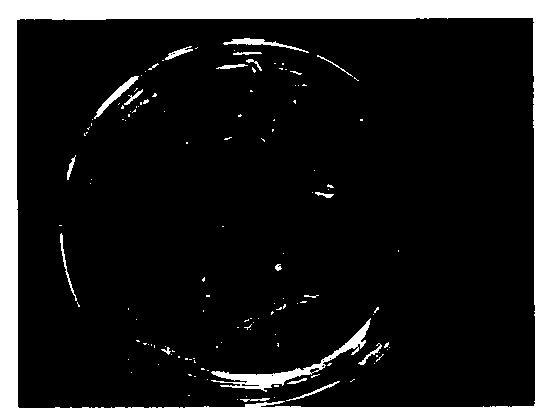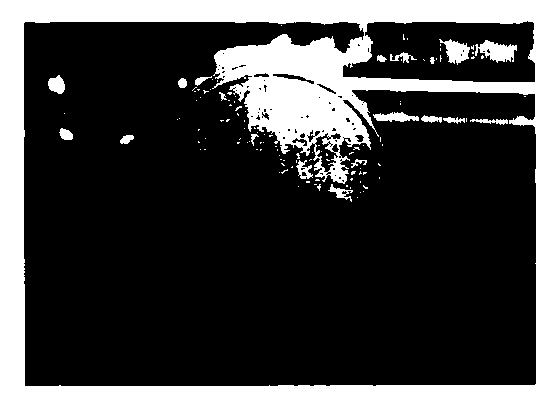A method for inducing and cultivating stevia hairy roots to produce chlorogenic acid and dicaffeoylquinic acid
A technology of caffeoyl quinic acid and stevia, applied in the field of genetic engineering, can solve the problems of not being effectively utilized, low content, etc., to achieve the improvement of growth and accumulation of secondary metabolites, reduce costs, and do not occupy arable land area. Effect
- Summary
- Abstract
- Description
- Claims
- Application Information
AI Technical Summary
Problems solved by technology
Method used
Image
Examples
Embodiment 1
[0037] Embodiment 1 Obtaining of stevia rebaudiana sterile explant
[0038] Manually remove the pappus on stevia seeds, incubate in a water bath at 20-40°C for 1-28 hours, blot dry with filter paper, sterilize stevia seeds with 70% alcohol for 20-60S, rinse with sterile water 2-3 times , and then disinfected with 0.1% mercury solution for 2-20 minutes, and rinsed with sterile water for 5-6 times. Inoculate on solid medium, the medium formula is: MS basic medium, 10-60g / L sucrose, 0.01-1mg / L NAA and 0-1mg / L BA, and then add 7-8g / L agar powder. Cultivate at a temperature of 25±2°C, cultivate in the dark for 10-20 days, and then move to a light room with a light intensity of 2000lx and a light time of 12h / d to obtain sterile seedlings.
Embodiment 2
[0039] Example 2 Obtaining hairy roots by genetically transforming Stevia rebaudiana with Agrobacterium rhizogenes
[0040] 1. Activation of Agrobacterium rhizogenes
[0041] Inoculate Agrobacterium rhizogenes on YEB solid medium containing rifampin antibiotics, pick a single colony, and inoculate it in YEB liquid medium containing rifampin antibiotics, at a temperature of 28-30°C, at a speed of 50-400r / min, and shake Cultivate overnight, then take 10-500 μL of the activated bacterial solution and add it to 10-50 mL of YEB (LB) liquid medium containing Rif and other antibiotics, culture at 28°C, shake at 50-400 rpm in the dark until the OD value is 0.5-1.0.
[0042] 2. Resuspension of Agrobacterium rhizogenes
[0043] Centrifuge at 10000-5000rpm at room temperature for 2-20min, discard the supernatant, resuspend the bacteria with an equal volume of 1 / 2MS, culture at 25-35℃, 50-200rpm in the dark for half an hour, so that the concentration of the bacteria solution reaches OD60...
Embodiment 3
[0052]Example 3 Molecular detection of hairy roots of Stevia rebaudiana
[0053] 1, the extraction of Stevia rebaudiana hairy root genomic DNA, the method is as follows:
[0054] 1) Take 100-200 mg of young stevia hairy roots, add liquid nitrogen and grind them into powder;
[0055] 2) Put the powdered stevia hairy root into a 1.5ml Eppendorf centrifuge tube, add 600μl of 2×CTAB preheated at 60°C and 10μl of mercaptoethanol, mix well and place in a 60°C water bath for 40- 50min, invert and mix from time to time;
[0056] 3) Add an equal volume of phenol (pH 8.0) to the lysate after cooling to room temperature, gently invert and mix, and let stand for 10 minutes;
[0057] 4) Centrifuge at 12000rpm for 20min, then pipette the milky white supernatant into a new tube, record the volume when pipetting;
[0058] 5) Add an equal volume of phenol:chloroform (1:1), gently invert and mix, and let stand for 10 minutes;
[0059] 6) Centrifuge at 12000rpm for 20min and transfer the mil...
PUM
 Login to View More
Login to View More Abstract
Description
Claims
Application Information
 Login to View More
Login to View More - R&D
- Intellectual Property
- Life Sciences
- Materials
- Tech Scout
- Unparalleled Data Quality
- Higher Quality Content
- 60% Fewer Hallucinations
Browse by: Latest US Patents, China's latest patents, Technical Efficacy Thesaurus, Application Domain, Technology Topic, Popular Technical Reports.
© 2025 PatSnap. All rights reserved.Legal|Privacy policy|Modern Slavery Act Transparency Statement|Sitemap|About US| Contact US: help@patsnap.com



